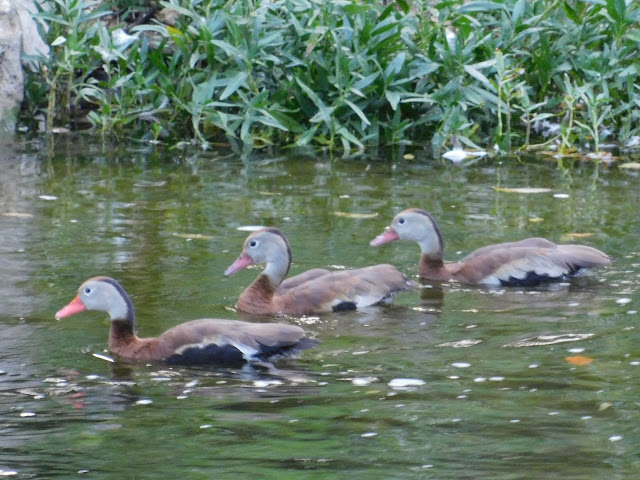WHISTLING DUCKS!
The Black-bellied Whistling-Duck is a boisterous duck
with a brilliant pink bill
and an unusual, long-legged silhouette.
~ All About Birds, Cornell University
We started our walk a little late today (I had to go back for my cell phone). We talked about the weather and our "to do" lists. I related what I'd seen at the ponds yesterday and promised to take my friend, VM, to see the Vermilion Flycatcher should it decide to stay in a spot easy to observe.* We greeted other walkers and the park employees and noted the usual birds - herons and vultures.
Then VM pointed out a group of ducks on a log. Odd. The "line-up" was quickly explained when we recognized they were our favorite ducks - Black-bellied Whistling Ducks. Even before we could see them clearly in the dim morning light we could hear their goofy peeping.
Over the last three or four years we have gone from noting them stopping at the creek during migration to having nesting pairs here.
Here are some of the photos...(only a few of the 50+ taken). The ducks stood around, swam, searched for food, and appeared to rest a bit. This is very likely a stop-over on migration south to Mexico. They don't migrate far, but I have not seen them over-winter in our area.***
 |
| It is even clearer here where the bright beaks, white wings, and black bellies show. |
 |
| I almost never catch them in a "whistle" or "peep." |
 |
| "You go first" "No, YOU go first!" |
 |
| Unipedal resting |
 |
| The female domestic mallard is moving smartly away from the BBWD. |
 |
| They are beautiful, but strange. |
 |
| The two ducks on the right are younger - note the beaks are not that bright orange of the adult. |
NOTES:
* So often a trip is a bore for someone expecting a certain kind of bird or experience. Fall and Winter are good times (any time is a good time really), but some bird crawls are better than others.
** Officially the "Tree" has been removed: The whistling-ducks were formerly known as tree-ducks, but only a few, such as the Black-bellied Whistling-Duck actually perch or nest in trees. They look most like ducks, but their lack of sexual dimorphism, relatively long-term pair bonds, and lack of complex pair-forming behavior more resembles geese and swans. (From All About Birds, Cornell University).
So I read this that they are part of the group of "Whistling Ducks" and since all whistling ducks are not "tree ducks" the "tree was removed from the name even as BBWD ARE tree nesting.
Names change. I love them no matter then name. I first saw them (that I remember) at our family vacation spot in the hill country and they are associated with my family (especially my brothers).
*** With climate change, that very well may change. 2020 was a banner year for nesting pairs in the parks and ponds I monitor. I observed at least 5 nesting pairs with sizable clutches. Prior to this year I remember seeing only one clutch (at Witter Lane about 4 years ago). I suppose we will see what happens next.











Comments
Post a Comment